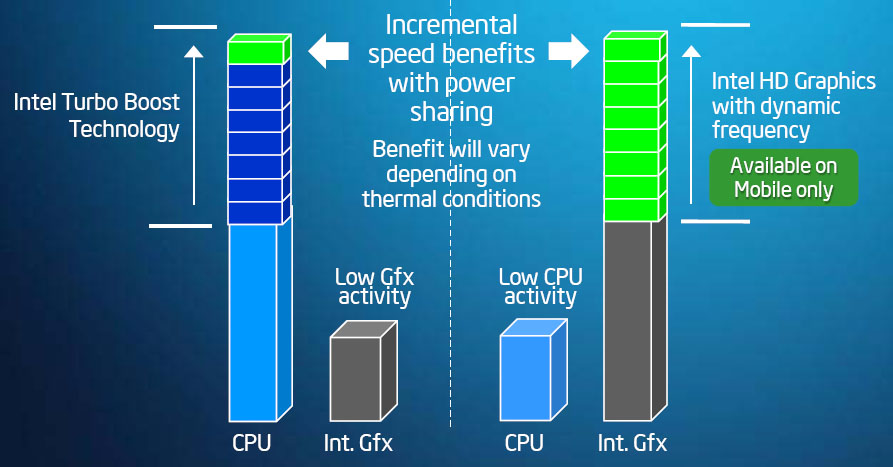Intel’s Mobile Core i5 And Core i3: Arrandale Is For The Rest Of Us
On-Package Graphics: Arrandale Versus Clarkdale
I went into ample depth on the HD Graphics built into Intel’s Clarkdale and Arrandale processors—for a quick recap, pull up this page.
With that said, while the 3D hardware remains the same between desktop and mobile CPUs, the Arrandale processors more intelligently handle the interaction between power and performance. You already know Turbo Boost technology, which capitalizes on thermal and power headroom to increase clock rate.
Intel’s mobile chips get a form of Turbo Boost that the company calls dynamic frequency, which ramps up the GPU’s core clock in response to graphics-intensive workloads. The entire processor package (consisting of 32nm CPU and 45nm GPU/memory/PCIe) is still subject to a maximum TDP rating. However, the two components are able to balance that budget depending on perceived utilization.
For example, in the dual-core standard voltage (35W) SKUs, the 32nm CPU die is actually rated for up to 25W typical consumption, while the integrated graphics and memory controller uses up to 12.5W with total package power not to exceed 35W. Within that power budget, the fastest CPU core (Intel’s Core i7-620M) runs at a 2.66 GHz base clock rate and can Turbo up to 3.33 GHz with a single core active. Or, if there’s a demanding workload hammering the GPU, available TDP can take the graphics core from 500 MHz as high as 766 MHz. In extreme cases, which Intel defines as occasions when the package isn’t thermally-constrained and able to violate its maximum power limits, the processor may use up to 29W, leaving 6W to the graphics and memory controller. Or, the graphics may use up to 20W, leaving 15W to the CPU.
The medium-voltage 25W chips are kept on an even tighter leash, scaling CPU speed from up to 2.13 GHz to as much as 2.93 GHz via Turbo Boost or pushing graphics from 266 MHz up to 566 MHz. Typically, the CPU will use up to 18W and the graphics core 9.5W. But again, there are concessions made for extreme cases in which you’ll see a 21/4W or 12/13W split between the two components. The point is that there’s enough intelligence built into these processors to manage a peak power ceiling given two die on the same package doing different jobs.
All in all, the dynamic frequency capability is really quite cool. And while its absence will be lamented by some on the desktop Clarkdale processors, Intel is already running the graphics core at 900 MHz on its Core i5-661 and 733/533 MHz on its other launch SKUs.
Switchable Graphics
Get Tom's Hardware's best news and in-depth reviews, straight to your inbox.
Mentioned previously in our Clarksfield (Core i7-920XM) coverage, switchable graphics is now supported across the Arrandale-based processors and 5-series chipsets. Of course, switchable graphics is the ability to swap between the CPU’s integrated graphics core and a discrete GPU without rebooting.
In that first exploration into Calpella, we decided that switchable graphics made the most sense matched to these Arrandale CPUs, since they already include integrated graphics as a standard capability. Moreover, there will undoubtedly be notebook vendors who pair mainstream processors with discrete GPUs for mid-range gaming capabilities. So, while switchable graphics has seen relatively little traction thus far (despite technically being supported since the days of Montevina), now is the time, if ever, we’d see it become more popular.
Current page: On-Package Graphics: Arrandale Versus Clarkdale
Prev Page The Arrandale Lineup: Something For (Almost) Everyone Next Page Mobile Chipsets, Refreshed-
burnley14 Well played, Intel. You've been knocking it out of the park lately, keep up the good work.Reply -
I'm looking forward to getting an HP laptop with the Arrandale Core i5 processor in the near future.Reply
-
It's going to be interesting to see the performance/battery time of the LM and UM processors as I'm in the market for a thin-and-light myself.Reply
Performance is good but I'm hoping for a viable update to the CULV offerings of yesterday. -
Computer_Lots Looks like there are finally some replacements for the Atom, at least in efficiency anyway. Too bad the price is currently too high for the UM versions of these processors to make their way into netbooks. I would guess that even the i5-520UM would destroy the Atom in every benchmark, except maybe power consumption.Reply -
HansVonOhain C2D was one of the longest living platforms. But newer tech will replace slower processors.Reply
Keep it up intel. I do hope that AMD will release some new chips that will be able to compete with intel offerings. -
jasperjones ^^^ true that. arrandale will further diminish AMD's role in the mobile processor market. and there's nothing coming up before may.Reply -
Luscious Chris, the dv4 series from HP has a 12-cell extended battery available as well rated for 94Wh 2.2A. Once HP makes the transition to Arrandale, all else being same, you can expect the dv4 to hit 8-10 hours easy.Reply -
cangelini Thanks for the tip Lucious. I didn't have the higher-capacity battery available to test, but I'd absolutely love to see 8-10 hrs. real-world from an Arrandale-based machine.Reply -
Reynod Good bye NVidia ...Reply
That chops them completely out of the mobile graphics market for the masses ... Intel will pay the RIGHT OEM's some "adjustment" just to make sure their "Strategy" is right to ensure AMD's mobile market is thin and restricted to the backwaters of Bejjing.

